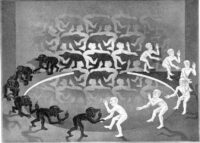What exactly is a moment, what we commonly call nowness? Does it have duration, and if so, how long is it; if not, does nowness actually exist at all? (Warning to the easily confused: This might be a good place to stop reading).
Nowness has no physical dimensions or fixed aspects: no size, no shape, no color, no sound – no characteristics of any kind. If Einstein is correct, it is not even a consistent, simultaneous moment, but varies with speed and mass (stop rushing, you’ll live longer).
Despite its lack of characteristics or tangible qualities, each of us nonetheless recognize nowness, and know it experientially. In other words, we experience something that cannot absolutely be found, pinpointed, captured, confined, defined, replicated or reduced. Each moment of nowness is unique, completely new and original (unlike most Hollywood movies today).
Speculation about nowness is speculation about time. Physicist Julian Barbour in his book The End of Time, proposes that time does not exist at all. In his model, what we experience as the flow of time is simply our consciousness splicing together discrete, completed static arrangements of space and matter, much like individual frames within a movie. Each static arrangement, moreover, differs from one’s point of view, of which there are an infinite number. Therefore, in place of linear time we exist in a knitted-together conscious continuity of static arrangements in which nothing actually moves and nothing actually happens (unless it’s in the NY Times, of course). When asked by two Zen monks which is moving, a flapping flag or the wind, a third monk answered, “Neither. Mind is moving.”
Modern physics has rushed across the threshold of common sense and stepped into the realm of paradox. Current theories aver that quantum events are not absolute, but instead are a function of probability. Sub-atomic history is not fixed, but actually alters due to choices made by the experimenter in the present moment. Time is plastic, curved and contained within space (a metaphysical Tupperware universe?).
Devoid of any solid nature, and neither absolutely true nor absolutely false, our experience of nowness seems quite real nonetheless. When perceived fully, the open-ended unfolding of nowness actually dissolves the duality of past and future, which may be why its presence can be so palpable and powerful. To be “in the moment” is an experience we all share, as is the sense of time “stopping.” Even when our distracted minds are entirely elsewhere, there is no escaping nowness. Thoughts of the past or plans for the future take place only in nowness.
Herewith we find a great experiential paradox: we perceive a nowness that may not exist; it is perhaps (a) a transitional moment of no duration or (b) a completed arrangement which ceases to exist as soon as it comes into existence, (c) neither, or (d) something else again as yet to be determined. In any case, something or nothing is happening, and we are happening or not happening right along with it. There are those who say that nowness is simply the product of attention, and doesn’t exist without us to observe it. To verify that hypothesis, however, requires proving a negative, yet again another mind-bending paradox. Alas, we’ve come full circle with no answers.
Enjoying nowness, gratefully, is not a matter of intellect.




